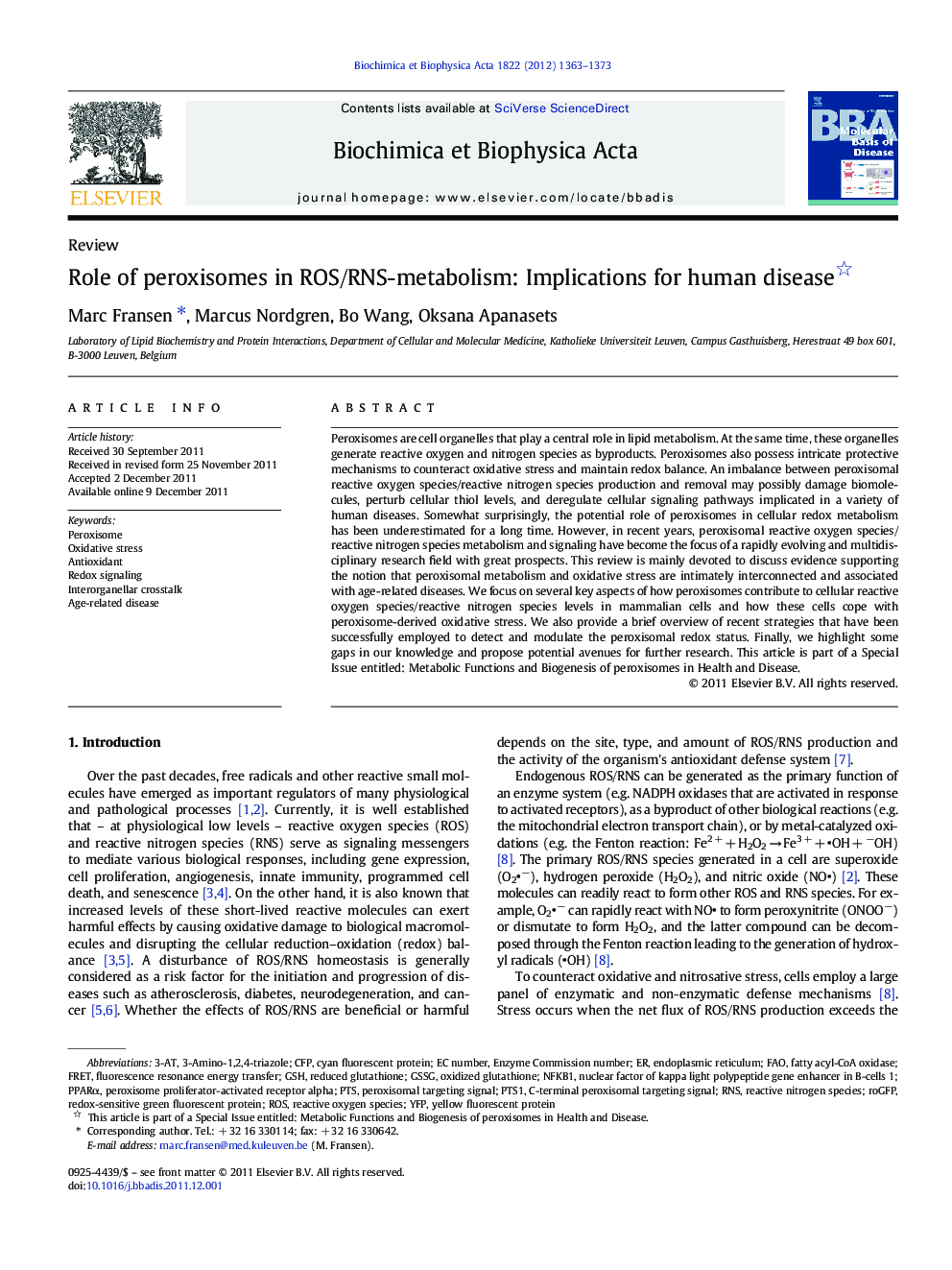| Article ID | Journal | Published Year | Pages | File Type |
|---|---|---|---|---|
| 1904911 | Biochimica et Biophysica Acta (BBA) - Molecular Basis of Disease | 2012 | 11 Pages |
Peroxisomes are cell organelles that play a central role in lipid metabolism. At the same time, these organelles generate reactive oxygen and nitrogen species as byproducts. Peroxisomes also possess intricate protective mechanisms to counteract oxidative stress and maintain redox balance. An imbalance between peroxisomal reactive oxygen species/reactive nitrogen species production and removal may possibly damage biomolecules, perturb cellular thiol levels, and deregulate cellular signaling pathways implicated in a variety of human diseases. Somewhat surprisingly, the potential role of peroxisomes in cellular redox metabolism has been underestimated for a long time. However, in recent years, peroxisomal reactive oxygen species/reactive nitrogen species metabolism and signaling have become the focus of a rapidly evolving and multidisciplinary research field with great prospects. This review is mainly devoted to discuss evidence supporting the notion that peroxisomal metabolism and oxidative stress are intimately interconnected and associated with age-related diseases. We focus on several key aspects of how peroxisomes contribute to cellular reactive oxygen species/reactive nitrogen species levels in mammalian cells and how these cells cope with peroxisome-derived oxidative stress. We also provide a brief overview of recent strategies that have been successfully employed to detect and modulate the peroxisomal redox status. Finally, we highlight some gaps in our knowledge and propose potential avenues for further research. This article is part of a Special Issue entitled: Metabolic Functions and Biogenesis of peroxisomes in Health and Disease.
Graphical abstractSchematic overview of the potential sources, sinks, and targets of peroxisomal ROS/RNS. Peroxisomes contain various enzymes that produce hydrogen peroxide (H2O2), superoxide (O2−), or nitric oxide (NO) as part of their normal catalytic cycle. These molecules can readily react to form other ROS and RNS such as peroxynitrite (ONOO−), hydroxyl radical (OH), and alkyl peroxides (ROOH). Peroxisomes are also well equipped with enzymatic and non ezymatic antioxidant defense systems, including catalase (CAT), superoxide dismutase 1 (SOD1), peroxiredoxin 5 (PRDX5), glutathione S‐transferase kappa (GSTK1), ‘microsomal’ glutathione S‐transferase (MGST1), epoxide hydrolase 2 (EPHX2), reduced glutathione (GSH) and vitamin C (VitC). GSH and VitC most likely freely penetrate the peroxisomal membrane through PXMP2, a non‐selective pore‐forming protein with an upper molecular size limit of 300–600 Da. How oxidized glutathione (GSSG) is reduced inside the peroxisomal matrix or exported back into the cytosol, is not yet known. The precise substrates of GSTK1, MGST1, and EPHX2 also remain to be identified. Excess peroxisomal ROS/RNS can directly inactivate peroxisomal matrix proteins or promote the production of potential signaling molecules such as S‐nitrosoglutathione (GSNO). Alternatively, some of these small reactive molecules may induce membrane damage through lipid peroxidation or diffuse out of the organelle. The latter event may perturb the cellular redox status, a condition generally considered as a risk factor for the development of age‐related diseases. Finally, under conditions of increased oxidative stress, peroxisomes may also function as a sink for cellular ROS. However, such conditions may in turn affect various peroxisomal functions, including the PEX‐mediated import pathway of peroxisomal matrix protein. XDH, xanthine oxidase; NOS2, inducible nitric oxide synthase; GRX, glutaredoxin; ROH, alcohol; ONO−, nitrite.Figure optionsDownload full-size imageDownload high-quality image (183 K)Download as PowerPoint slideHighlights► Peroxisomes may function as a source, sink, or target of small reactive molecules. ► Peroxisomal ROS/RNS can deregulate redox-sensitive signaling pathways. ► Peroxisomes and mitochondria share a redox-sensitive relationship. ► Altered peroxisomal redox homeostasis is linked with age-associated diseases. ► Enhanced cellular oxidative stress can impair peroxisome function.
